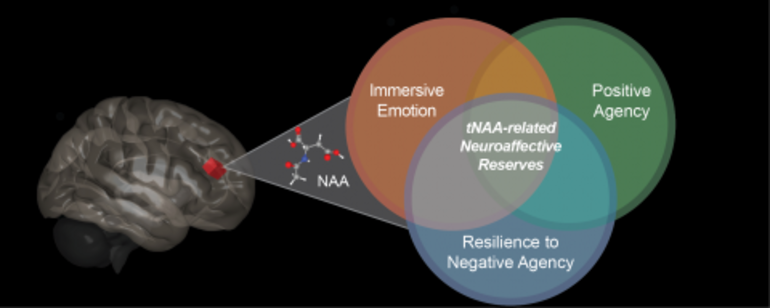Summary: NAA, a compound in the brain, plays a key role in emotional agency and flexibility in healthy people.
Source: Brown University
A new study is the first to reveal specific brain compounds that signal emotional wellness in healthy people.
Scientists at Brown University’s Carney Institute for Brain Science used proton magnetic spectroscopy (1H-MRS), a noninvasive brain imaging technique, to determine how specific biochemical compounds in the brain relate to daily emotions. The researchers focused on two emotions: agency, the ability to shape one’s world, and flexibility, the ability to fluidly respond to events as they unfold. The study is the first to identify that a compound in the brain called NAA plays a key role in agency and flexibility in healthy people.
The study was published on October 27 in NeuroImage, a journal that communicates advances in brain-behavior relationships that can be assessed by non-invasive imaging methods. The work was led by Tara White, assistant professor of behavioral and social sciences (research) at Brown, and her team at Brown, the University of Florida and the University of Calgary.
“Agency and flexibility are important aspects of everyday life,” said White, who is affiliated with the Carney Institute and the Center for Alcohol and Addiction Studies in Brown’s School of Public Health. “Our data provide insight on the brain mechanisms that support agency, immersive emotion and resilience to aggression in healthy people.”
NAA, which is found at high concentrations within neurons, is considered a marker of neuronal health. The researchers found that NAA was strongly related to three traits in healthy individuals: emotional fluidity, positive agency and non-aggression.
The NAA compound was evaluated within the dorsal anterior cingulate, a brain region involved in multiple networks of emotion, cognition and behavior. According to the study, individuals with a higher level of NAA reported more immersive and richer emotion in comparison to those with lower NAA, as well as a higher level of goal directedness, more positive emotion and less aggression. The researchers define the relationship of NAA with agency and flexibility in healthy people as a novel dimension termed “Neuroaffective Reserves.”
“These findings tell us how immersive emotion, positive agency and resilience to aggression work in the human brain,” White said. “These findings indicate NAA and other brain compounds play a fundamental role in emotional wellness and positive emotional outcomes in healthy individuals.”
The researchers also found that behavioral flexibility and engagement were moderately related to glutamatergic compounds involved in excitatory neurotransmission, learning, memory and goal-directed behavior, White said.

Additionally, affiliative bonding was related to Choline, a precursor of the neurotransmitter acetylcholine, which is involved in emotional learning. These findings inform the brain foundations of positive emotion, engagement and interpersonal connection in healthy people.
“This imaging approach is interesting because these biochemical compounds could be used as an objective brain marker for traits related to wellness,” said Meghan Gonsalves, an author of the study and a Ph.D. student at Brown who holds both bachelor’s and master’s degrees from the University.
As a next step, White and her team will establish a three-pronged research program on brain metabolites that contribute to emotions in healthy adults. White received a Zimmerman Innovation Award last year from the Carney Institute to collect the preliminary data on this topic. The long-term goal, she said, is to build a research program on the neurobiology of human emotion at Brown.
Funding: The research was funded by the National Institute on Drug Abuse (DA R21 029189).
About this emotion and neuroscience research news
We would like to thank Tara White for submitting this research news for inclusion on NeuroscienceNews.
Source: Brown University
Contact: Tara White – Brown University
Image: The image is credited to White Lab / Brown University
Original Research: Open access.
“The neurobiology of wellness: 1H-MRS correlates of agency, flexibility and neuroaffective reserves in healthy young adults” by Tara White et al. NeuroImage.
Abstract
The neurobiology of wellness: 1H-MRS correlates of agency, flexibility and neuroaffective reserves in healthy young adults
Proton magnetic resonance spectroscopy (1H-MRS) is a noninvasive imaging technique that measures the concentration of metabolites in defined areas of the human brain in vivo. The underlying structure of natural metabolism-emotion relationships is unknown. Further, there is a wide range of between-person differences in metabolite concentration in healthy individuals, but the significance of this variation for understanding emotion in healthy humans is unclear. Here we investigated the relationship of two emotional constructs, agency and flexibility, with the metabolites glutamate and glutamine (Glx), N-acetylaspartate (tNAA), choline (Cho), creatine (tCr), and myo-inositol (Ins) in the right dorsal anterior cingulate cortex (dACC) in medically and psychiatrically healthy volunteers (N = 20, 9 female; mean age = 22.8 years, SD = 3.40). The dACC was selected because this region is an integrative hub involved in multiple brain networks of emotion, cognition and behavior. Emotional traits were assessed using the Multidimensional Personality Questionnaire Brief Form (MPQ-BF), an empirically derived self-report instrument with an orthogonal factor structure. Phenotypes evaluated were positive and negative agency (MPQ-BF Social Potency, Aggression), emotional and behavioral flexibility (MPQ-BF Absorption, Control-reversed), and positive and negative affect (MPQ-BF Social Closeness; Stress Reaction, Alienation). The resting concentration of tNAA in the dACC was robustly positively correlated with Absorption (r = +0.56, unadjusted p = .005), moderately positively correlated with Social Potency (r = +0.42, unadjusted p = .03), and robustly negatively correlated with Aggression (r = -0.59, unadjusted p = .003). Absorption and Aggression accounted for substantial variance in tNAA (R2 = 0.31, 0.35; combined R2 = 0.50), and survived correction for multiple comparisons (Holm-Bonferroni adjusted p = .032, 0.021, respectively). dACC Glx and Cho had modest relationships with behavioral flexibility and social affiliation that did not survive this multiple correction, providing effect sizes for future work. Principal Component Analysis (PCA) revealed a three-factor orthogonal solution indicating specific relationships between: 1) Glx and behavioral engagement; 2) Cho and affiliative bonding; and 3) tNAA and a novel dimension that we term neuroaffective reserves. Our results inform the neurobiology of agency and flexibility and lay the groundwork for understanding mechanisms of natural emotion using 1H-MRS.







